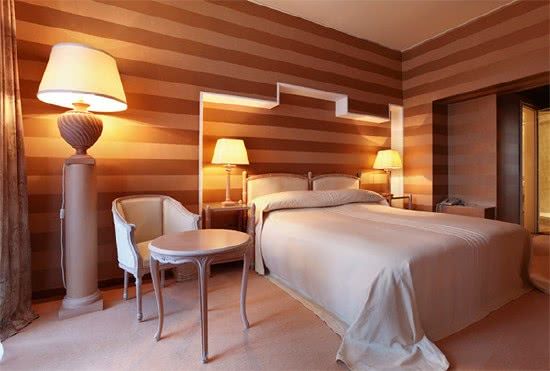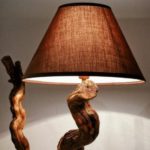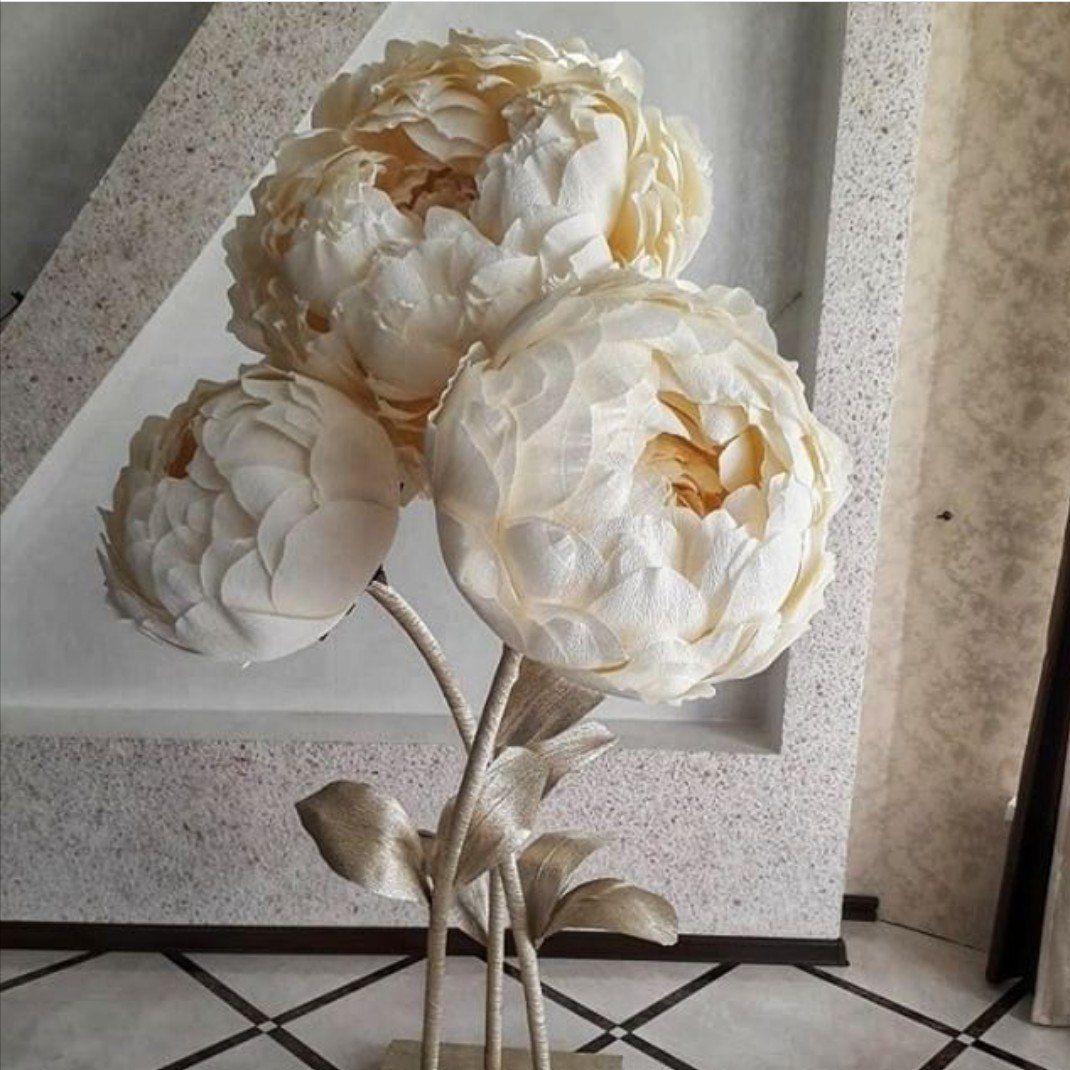Floor lamp is
For local lighting, compact table lamps and pendant sconces are often used. However, you shouldn’t limit yourself to them only. Try reading in the evening under a floor lamp - and you will not want to return to your previous options.
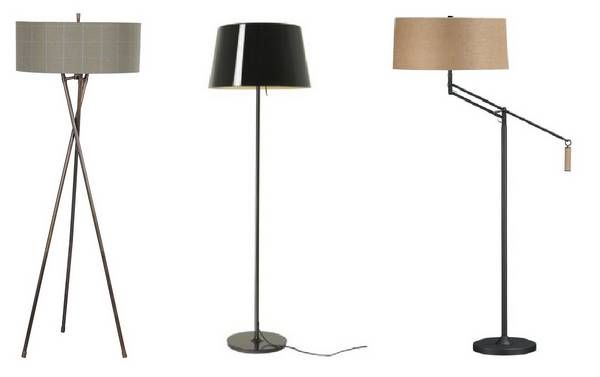
The content of the article
What is a floor lamp?
A floor lamp is a floor lamp, the classic version of which consists of a base, a column and a lampshade. In modern interpretations, the function of the base and the leg is sometimes performed by the same element, and the lampshade may be absent altogether.

Main features
Key differences from other lighting devices: installation method and the presence of a light-diffusing lampshade. My eyes don't get tired of it. This property is valued by book lovers: they place floor lamps next to the sofas and armchairs where they usually spend their leisure time.
Also, with the help of such a lamp it is easy to zone a room; you can find a lot of photos on this topic. It will light up the work area and a place to rest. Some people use paired floor lamps to highlight the exit from the room, but this is not entirely the right approach. A tall floor lighting source is not stable enough for such use.
IMPORTANT. It is generally accepted that a floor lamp must be tall. Now this myth is being diligently dispelled. Along with the classic 1.5-meter ones, 60–70-centimeter devices are produced. And they are not always installed on the floor. Sometimes they are placed on the table.
An additional function of the lamp is decorative. It can become the main decoration in the room, a bright spot due to an unusual column, ornate or stylized lampshade.
Varieties
Floor lamps are divided according to the following principles:
 material of the floor lamp, base and column;
material of the floor lamp, base and column;- dimensions (height, massiveness);
- installation method (on the floor or on a horizontal surface);
- the presence of additional elements (for example, shelves);
- control method (presence and location of power buttons, possibility of remote activation and configuration);
- the ability to adjust the power of the light flux (this is possible with a dimmer);
- leg shape (straight, curved, flexible, articulated, tripod);
- presence and number of lampshades;
- type of lighting (accent, background, main).
There are also models with directed, reflected and diffused light. The classic version of floor lamps is a source of scattered rays. If the rotation and tilt of the lamp can be changed, then we are talking about a directional type. In the reflected form, it is necessary to include walls, ceilings, floors or other interior items: with their help, rays spread, refract and are reflected.
Devices are produced that are characterized by 2 or even 3 lighting methods at once. Typically, this opportunity opens up if there are additional lampshades: the central one sends scattered or reflected rays, the side one sends directed ones. This design is often shaky, but it is convenient for reading and doing handicrafts.
Material of manufacture
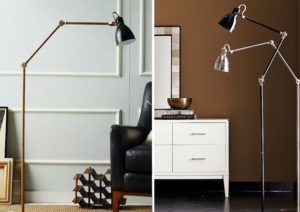 Material is closely related to style. The classical direction is characterized by the use of fabric and paper in the manufacture of lampshades, for country - wood and metals, for Provence - fabric (usually richly embroidered or decorated with ribbons), for high-tech - metal and glass. Glass and crystal mosaic lampshades often hint at Tiffany, while those created from twigs and branches refer to eco-style and oriental traditions. Japanese and Chinese styles are also visible in terms of decor. These movements are characterized by minimalism. The base is very often made of wood (classic, oriental, eco-style, country), stone, metal (high-tech, art deco), clay. Columns are made from clay, willow twigs, metal, glass, plastic, rattan.
Material is closely related to style. The classical direction is characterized by the use of fabric and paper in the manufacture of lampshades, for country - wood and metals, for Provence - fabric (usually richly embroidered or decorated with ribbons), for high-tech - metal and glass. Glass and crystal mosaic lampshades often hint at Tiffany, while those created from twigs and branches refer to eco-style and oriental traditions. Japanese and Chinese styles are also visible in terms of decor. These movements are characterized by minimalism. The base is very often made of wood (classic, oriental, eco-style, country), stone, metal (high-tech, art deco), clay. Columns are made from clay, willow twigs, metal, glass, plastic, rattan.
Dimensions
Helpful notes regarding sizing:
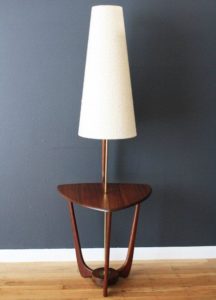 a tall floor lamp is not suitable for a small room with a low ceiling (it will begin to serve as central lighting, but the room will not be filled with light as evenly as from a chandelier);
a tall floor lamp is not suitable for a small room with a low ceiling (it will begin to serve as central lighting, but the room will not be filled with light as evenly as from a chandelier);- a low floor lamp will get lost among massive furniture;
- in spacious rooms with really high ceilings, floor lamps over 1.5 m high are installed;
- one and a half meters and slightly lower are suitable for the area next to an armchair, table, bed;
- small models - about a meter or less in height - have a decorative function (they are not suitable for working or reading, in these cases you need to use additional lighting sources).
You should also be careful when purchasing a tall floor lamp, whose very flexible and thin column ends in 1 large lampshade or many small ones. This design is too shaky; its direction-changing leg will eventually begin to hold the lampshades worse (it will begin to sag under their weight).
Modern solutions
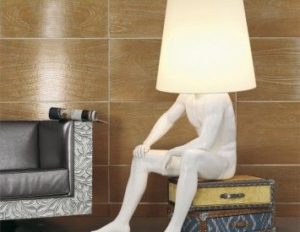 Devices in which the lighting sources are hidden look interesting. Until you turn on such a floor lamp, it will look like a sculpture or monument. Stylized lamps are also worthy of attention. You can immediately see from them which style direction they belong to. Due to the presence of such products on the market, it is difficult to make a mistake and buy a model that does not harmonize with the situation. Another merit of modern designers: their departure from classical norms made it possible to solve the problem of unsteadiness. Nowadays you can find a very stable floor lamp not on one thin leg, but on a thick one or several at once. In contrast to such reliable and safe options, fire hazardous ones are also being implemented. These include models that have an elongated glass column and a light source. The first time such a lamp falls, it will break and, most likely, become a source of fire.
Devices in which the lighting sources are hidden look interesting. Until you turn on such a floor lamp, it will look like a sculpture or monument. Stylized lamps are also worthy of attention. You can immediately see from them which style direction they belong to. Due to the presence of such products on the market, it is difficult to make a mistake and buy a model that does not harmonize with the situation. Another merit of modern designers: their departure from classical norms made it possible to solve the problem of unsteadiness. Nowadays you can find a very stable floor lamp not on one thin leg, but on a thick one or several at once. In contrast to such reliable and safe options, fire hazardous ones are also being implemented. These include models that have an elongated glass column and a light source. The first time such a lamp falls, it will break and, most likely, become a source of fire.
IMPORTANT. The lampshade is a beautiful detail typical of floor lamps. If it is made of unbreakable material - leather, fabric, plastic or metal - it can be regarded as additional protection for the light bulb.
How to choose
First, it’s worth determining exactly where and how the floor lamp will be used. Based on this point it is easy to find out:
- required level of protection from moisture and dust (marking: IP);
- power;
- weight and size.
A classic type of stable structure made of moisture-resistant materials (IP should be above 20) is suitable for a nursery. For the kitchen, buy a lighting fixture with a protection level of IP54, for the bathroom - a floor lamp with an IP65 rating. For a regular living room, look for a lighting fixture with IP20.
IMPORTANT. The indicated values are relevant only for dry apartments and private houses.If the room is damp, moisture seeps from the roof or basement, then you should choose a floor lamp with an enhanced moisture protection system.
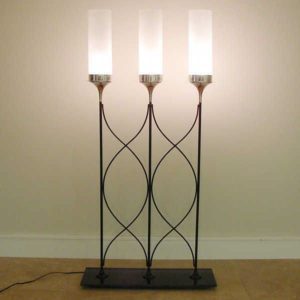 The permissible limits of weight and size can also be calculated if you take into account the method and place of operation. If the device is not purchased for a specific room and not for a specific place in it, it means that it will be moved and rearranged. Therefore, it should not weigh a lot and be too tall (this will affect stability). Unusual proportions can also affect stability - it is difficult to balance a floor lamp whose column is bent, tilted, or in addition to the central shade there is another one located on the side. In the latter case, the second lampshade will outweigh, unless the manufacturer figures out how to balance the structure. Because of this, the lamp will often fall, which, in turn, is fraught with fire. An even greater threat is posed by lighting devices, the design of which, in general, does not have a lampshade. The location for them is selected taking into account the high risk of fire. They definitely should not be used in rooms with a large flow of people, in children's rooms, living rooms, kitchens, hallways and restrooms. But they will fit well into the interior of a bachelor’s home, a home office and a room for needlework - wherever an adult is in privacy and away from sources of humidity, as well as where animals and children have no access.
The permissible limits of weight and size can also be calculated if you take into account the method and place of operation. If the device is not purchased for a specific room and not for a specific place in it, it means that it will be moved and rearranged. Therefore, it should not weigh a lot and be too tall (this will affect stability). Unusual proportions can also affect stability - it is difficult to balance a floor lamp whose column is bent, tilted, or in addition to the central shade there is another one located on the side. In the latter case, the second lampshade will outweigh, unless the manufacturer figures out how to balance the structure. Because of this, the lamp will often fall, which, in turn, is fraught with fire. An even greater threat is posed by lighting devices, the design of which, in general, does not have a lampshade. The location for them is selected taking into account the high risk of fire. They definitely should not be used in rooms with a large flow of people, in children's rooms, living rooms, kitchens, hallways and restrooms. But they will fit well into the interior of a bachelor’s home, a home office and a room for needlework - wherever an adult is in privacy and away from sources of humidity, as well as where animals and children have no access.
In terms of power, you can rely on the following comments:
- for an analogue night light, 50 W is enough;
- background and dim lighting is created using 100 W floor lamps;
- Install a device with a power of 150 W next to the chair;
- lamps in which 200 W lamps can be installed will replace central lighting;
- 500 W is already an option for industrial premises or for spacious rooms in mansions.
In no case should the manufacturer's instructions regarding the power of light bulbs be ignored. This may cause the lamp to break down and cause a fire.
